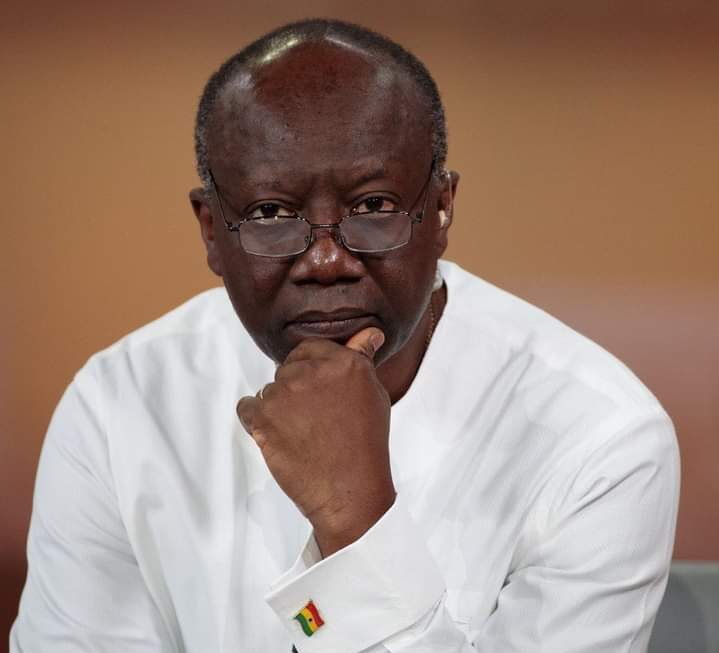Bank of Ghana Governor Dr Ernest Addison has said as far as the execution of the budget is concerned, “provisional data released by the Ministry of Finance as of November 2020, showed an overall broad cash budget deficit of 10.8 per cent of GDP against the target of 11.4 per cent of GDP for the year”.
Chairing the Monetary Policy Committee meeting on Monday, 1 February 2020 at which the policy rate was maintained at 14.5 per cent, Dr Addison said: “The primary balance also recorded a deficit of 4.9 per cent of GDP which was marginally above the target of 4.8 per cent of GDP”.
“Over the review period, total revenue and grants amounted to GHS46.5 billion (12.1 per cent of GDP), marginally higher than the revised target of GHS46.0 billion (11.9 per cent of GDP)”, he reported.
Total expenditures and arrears clearance amounted to GHS88.2 billion (22.9 per cent of GDP) against the revised target of GHS88.4 billion (22.9 per cent of GDP), he noted.
The “elevated fiscal path”, he indicated, “has impacted the stock of public debt which rose to 74.4 per cent of GDP (GHS286.9 billion) at the end of November 2020 compared with 62.4 per cent of GDP (GHS218.2 billion) at the end of December 2019”.
“Of the total debt stock, domestic debt was GHS147.3 billion (38.2 per cent of GDP), while external debt was GHS139.6 billion (36.2 per cent of GDP)”, Dr Addison added.
Read the full statement below:
Good morning, Ladies and Gentlemen of the Media. Welcome to the 98th Monetary Policy Committee (MPC) press briefing, and the first in the year 2021. The MPC met last week and reviewed recent global and domestic developments including the outlook for the economy. Permit me to share with you highlights of the developments and key considerations that informed the decision of the Committee on the Policy Rate.
1. The global economy was projected to contract by a larger margin in 2020 due to the adverse effects of the COVID-19 pandemic, but the contraction has turned in better than earlier forecasted. The resurgence of infections and emergence of new variants of the virus since the last quarter of 2020 has, however, resulted in the re-imposition of restrictions and partial lockdowns in some economies and will likely soften the growth recovery momentum in early 2021. Notwithstanding the anticipated softening, global growth is expected to strengthen in the second half of 2021, conditional on continued policy support and successful rollout of COVID-19 vaccines. Prospects for 2021 look more positive, and the January update of the IMF’s World Economic Outlook projects a rebound in the global economy from the 3.5 per cent contraction in 2020 to a 5.5 per cent growth in 2021, amid uncertainties.
2. Global financing conditions remained accommodative throughout 2020, reflecting the massive policy support which induced lower borrowing costs, boosted equity valuations, enhanced investor risk appetite, and narrowed sovereign bond spreads across Emerging Market and Developing Economies. These developments helped ease pressures on emerging and frontier market currencies, while sovereign risk spreads for most sub-Saharan African countries declined steadily in the year. In the near-term, financial market indicators point to optimism about medium-term prospects. Nonetheless, rising debt levels and increasing interest burdens across several emerging markets and developing economies pose significant financing risks.
3. Global inflationary pressures remained subdued, weighed down by weak global demand and significant slack in labour and product markets during 2020. In Advanced Economies, inflation is projected to rise to 1.3 per cent in 2021 from 0.7 per cent in 2020, while in Emerging Market and Developing Economies, inflation is expected to ease slightly to 4.2 per cent from 5.0 per cent over the same comparative period. In emerging market and frontier economies, currency movements and COVID-related supply-side constraints are expected to dictate price movements, going forward.
4. In Ghana, after recording strong growth of 6.5 per cent in 2019 and firm growth of 4.9 per cent in the first quarter of 2020, growth was dampened in the second quarter due to COVID-related factors. However, following the lifting of restrictions and strong policy support, signs of recovery begun to emerge in the third quarter. Data released by the Ghana Statistical Service showed that real GDP growth provisionally contracted by 1.1 per cent in the third quarter of 2020 compared to the 3.2 per cent contraction recorded in the second quarter. In particular, non-oil GDP recorded a more measured contraction of 0.4 per cent in the third quarter of 2020, compared to a contraction of 3.4 per cent in the second quarter.
5. The Bank of Ghana’s updated Composite Index of Economic Activity (CIEA) recorded an annual growth of 11.9 per cent in November 2020, compared with 3.4 per cent growth a year ago. The key drivers of economic activity during the period were construction, port activity, imports, manufacturing, and credit to the private sector.
6. Results from the Bank’s latest confidence surveys conducted in December 2020 showed improvements in both consumer and business confidence. Consumer confidence remained firm at pre-lockdown levels reflecting optimism about current economic conditions following the gradual lifting of the COVID-related restrictions. Business confidence improved significantly, reaching pre-lockdown levels, for the first time, as businesses met short-term company targets and expressed positive sentiments about growth prospects.
7. Price developments in 2020 were broadly driven by COVID-related factors, especially the spike in inflation observed during the second quarter which was on the back of events preceding the partial lockdown. This was followed by the subsequent easing in inflation pressures in the third and last quarters, as the restrictions were removed. Two readings since the last MPC meeting indicated that headline inflation eased from 10.1 per cent in October to 9.8 per cent in November and then, subsequently rose to 10.4 per cent in December 2020. The inflation uptick in December was mainly driven by food inflation, which moved up to 14.1 per cent from 11.7 per cent in November. Non-food inflation, however, eased to 7.7 per cent from 8.3 per cent over the same comparative period.
8. Underlying inflation pressures inched up marginally in line with the headline inflation trends. The Bank’s core inflation measure, which excludes energy and utility, went up marginally, while inflation expectations of businesses and consumers moderated. Financial sector inflation expectations inched up marginally.
9. On execution of the budget, provisional data released by the Ministry of Finance as of November 2020, showed an overall broad cash budget deficit of 10.8 per cent of GDP against the target of 11.4 per cent of GDP for the year. The primary balance also recorded a deficit of 4.9 per cent of GDP which was marginally above the target of 4.8 per cent of GDP. Over the review period, total revenue and grants amounted to GH¢46.5 billion (12.1 per cent of GDP), marginally higher than the revised target of GH¢46.0 billion (11.9 per cent of GDP). Total expenditures and arrears clearance amounted to GH¢88.2 billion (22.9 per cent of GDP) against the revised target of GH¢88.4 billion (22.9 per cent of GDP).
10. The elevated fiscal path has impacted the stock of public debt which rose to 74.4 per cent of GDP (GH¢286.9 billion) at the end of November 2020 compared with 62.4 per cent of GDP (GH¢218.2 billion) at the end of December 2019. Of the total debt stock, domestic debt was GH¢147.3 billion (38.2 per cent of GDP), while external debt was GH¢139.6 billion (36.2 per cent of GDP).
11. Total liquidity increased significantly during the year driven by government’s fiscal stimulus programme, the complementary monetary policy measures implemented during the year to mitigate the impact of the COVID-19 pandemic, and the monetisation of government bonds to pay depositors in the SDI sectors, as well as the central bank’s purchase of a GH¢10 billion COVID-19 bond issued by the government. These policies led to a large expansion in the balance sheet of the central bank. As a result, Net domestic assets increased by 42.2 per cent year-on-year in 2020, compared with a modest 15.0 per cent growth in 2019, while net foreign assets contracted by 12.6 per cent, compared with 51.7 per cent growth in the same comparative periods. Broad money (M2+) grew by 29.6 per cent in 2020, compared with 21.7 per cent growth in 2019. The expansion in M2+ was mainly on account of increased growth in net domestic assets of the depository sector. The growth in M2+ reflected in expansion in currency outside banks and domestic deposits.
12. Commercial banks’ balance sheets also saw growth during the year due to the expansionary government policy and the increase in deposits mobilised from the SDI sector due to a flight to quality from depositors in the SDI sector. Total deposits increased by 26.8 per cent, and net claims on government by commercial banks increased by 44.6 per cent. On the other hand, credit extended to the private sector moderated throughout 2020. On an annual basis, net credit to the private sector slowed to 5.8 per cent in December 2020 compared with 23.8 per cent in the corresponding period in 2019. On a gross basis, credit to the private sector grew by 10.6 per cent compared with 18.0 per cent over the same comparative period.
13. Interest rates on the money market broadly showed downward trends across the yield curve. The 91-day declined to 14.1 per cent in December 2020 from 14.7 per cent last year, and the 182-day Treasury bill rate fell to 14.1 per cent from 15.2 per cent over the same comparative period. On the secondary bond market, yields on 6-year, 7-year, 10-year, and 15-year bonds all declined. The rates on the 20-year bond, however, inched up marginally to 22.3 per cent in December 2020 relative to 22.1 per cent in December 2019.
14. The weighted average interbank rate declined to 13.6 per cent from 15.2 per cent, reflecting the reduction in the monetary policy rate in March 2020, and improved liquidity conditions on the market. Similarly, average lending rates of banks declined to 21.1 per cent in December 2020 from 23.6 per cent recorded in the corresponding period of 2019, consistent with the monetary policy stance.
15. The banking sector showed resilience to the first wave of the pandemic supported by strong policy support and regulatory reliefs. Banking sector performance remained strong through end 2020, with robust growth in total assets, deposits and investments. Overall, the impact of COVID-19 on the industry’s performance was moderate as banks remained liquid, profitable and well-capitalised. Total assets increased by 15.8 per cent, of which Investments in Government bonds rose by 33.4 per cent.
16. Solvency and liquidity indicators remained strong. The industry’s CAR of 19.8 per cent as at end December 2020 was also well above the regulatory minimum threshold. Core liquid assets to short term liabilities were estimated at 27.8 per cent in December 2020 compared with 30.5 per cent a year ago. Net interest income grew by 20.9 per cent to GH¢11.2 billion compared to 24.9 per cent a year ago. Net fees and commissions grew by 5.0 per cent to GH¢2.3 billion, lower than the growth of 16.5 per cent recorded in the prior year, reflecting the dip in growth of credits and other trade finance-related businesses. Operating income rose by 17.9 per cent whilst operating expenses rose by 8.2 per cent, albeit lower than the respective growth rates of 21.1 per cent and 12.1 per cent in 2019. Loan loss provisions grew by 28.0 per cent, higher than the 23.6 per cent a year ago reflecting elevated credit risks in 2020. Profit before tax increased by 27.2 per cent to GH¢6.1 billion compared to 34.7 per cent a year ago.
17. Implementation of the COVID-related regulatory reliefs and policy measures helped support lending activities. New Advances in 2020 grew by 15.8 per cent to GH¢34.4 billion in 2020. Banks provided support and reliefs in the form of loan restructuring and loan repayment moratoria to cushion 16,694 customers severely impacted by the pandemic. Total outstanding loans restructured by banks as at December 2020 amounted to GH¢4.47 billion, representing some 9.4 per cent of industry loan portfolio. Non-Performing Loans (NPL) ratio increased from 14.3 per cent in December 2019 to 15.7 per cent in June 2020 arising from the pandemic-induced repayment challenges, but declined to 14.8 per cent in December 2020 due to loan write-offs and increased credits, particularly during the last quarter.
18. Commodity price trends traded mixed in 2020, influenced by COVID-related global market conditions. Crude oil prices declined by 22.9 per cent year-on-year in December 2020, driven mainly by weak demand. Crude oil prices averaged US$50.2 per barrel, compared with US$65.2 per barrel a year ago. In contrast, gold prices went up by 25.4 per cent to an average of US$1,857.2 per fine ounce, strongly supported by accommodative monetary policy, increased uncertainty, and the global economic slowdown due to the pandemic. Cocoa prices averaged US$2,581.3 per tonne in December 2020, up by 2.5 per cent on a year-on-year basis.
19. These commodity price developments impacted on the trade balance. Total exports contracted by 7.8 per cent year-on-year to US$14.5 billion in 2020, driven mainly by a significant decline of US$1.6 billion in crude oil export receipts on the back of low prices. Gold and cocoa export earnings on the other hand, went up by 9.1 per cent and 2.1 per cent respectively, due to favourable prices and production volumes. Total imports went down by US$974 million to US$12.4 billion, underpinned by significant declines in both oil and non-oil imports. Consequently, the trade balance recorded a lower surplus of US$2.0 billion (3.0 per cent of GDP) in 2020, compared with US$2.3 billion (3.4 per cent of GDP) in 2019.
20. The current account recorded a deficit of US$2.0 billion (3.0 per cent of GDP) compared with a deficit of US$1.9 billion (2.8 per cent of GDP) in 2019 due to the lower trade surplus and higher services outflows which was moderated by the strong remittance inflows of US$3.6 billion and lower net investment income outflows, notably, profits and dividends.
21. Gross International Reserves at the end of December 2020 was US$8,624.4 million, providing cover for 4.1 months of imports of goods and services. The reserve level compares with the end-December 2019 position of US$8,418.1 million, equivalent to 4.0 months of import cover. Cumulatively, the Ghana cedi depreciated by 3.9 per cent against the US dollar in 2020, compared with a depreciation of 12.9 per cent in 2019. The Ghana cedi also depreciated by 7.1 per cent against the Pound and 12.1 per cent against the Euro, compared with 15.7 per cent and 11.2 per cent over the same comparative period.
Summary and Outlook
22. The global resurgence of Covid-19 infections has elevated uncertainties in the outlook, posing significant risks to the pace of recovery in the near-term. Global growth prospects remain positive, conditioned on a successful vaccine rollout across various countries, a gradual relaxation of the containment measures, and assured policy support. When well-coordinated, these will help support the much-anticipated global growth rebound in the second half of 2021. These conditions will also foster accommodative near-term monetary policies in Advanced Economies, and trigger a search for yield in Emerging Market and Developing Economies with strong fundamentals. Rising debt vulnerabilities in emerging market and frontier economies, including Ghana, on the other hand, pose significant risks and could potentially worsen investor risk appetite. These conditions will require managing fiscal risks in the outlook for the Ghanaian economy.
23. In the domestic economy, growth has picked up since the sharp contraction in the second quarter. All the high-frequency indicators of economic activity have rebounded, consumer and business confidence levels are back at pre-lockdown levels, and there are indications of steady growth in private sector credit. However, the renewed threat from the second-wave of the pandemic has again heightened uncertainty and could hamper the recovery process in the near-term.
24. The banking sector is well-positioned to continue with the core objective of financial intermediation and providing support to the growth recovery process. Banks are expected to sustain the strong performance under mild to moderate stress conditions, barring more severe consequences on the real sector from the second wave of the pandemic. Policy and regulatory reliefs granted to the industry will be reviewed alongside close monitoring and prompt supervisory actions will be taken to address emerging potential vulnerabilities in the financial sector arising from the pandemic.
25. The current account balance turned out better than earlier anticipated. However, lower-than-projected FDI flows and portfolio reversals resulted in a lower build-up of reserves than earlier projected. The gross reserves at US$8.6 billion, translating into 4.1 months of import cover, will provide adequate cushion against potential external vulnerabilities in 2021.
26. The prospects of a sharp fiscal correction in 2021 now looks unlikely amidst the second wave of the pandemic which will be requiring additional spending to provide testing, vaccines, etc. To put debt on a sustainable path and to ensure sustainability in policies, some new revenue measures and expenditure rationalisation efforts will have to be pursued within the context of the medium-term fiscal framework to allow for the generation of primary surpluses.
27. Headline inflation, while on steady decline in the early months of the last quarter of 2020, jumped in December to 10.4 per cent, outside the target band of 8±2 per cent, driven by food prices. However, the Bank projects headline inflation to return to target in the second quarter of 2021. Risks to inflation in the near-term are broadly contained, but short to medium-term risks emanating from the fiscal expansion and rising crude oil prices are emerging.
28. Under the circumstances, and given the balance of risks to inflation and growth, the Committee decided to keep the policy rate at 14.5 per cent.
Informational Note
The next Monetary Policy Committee (MPC) meeting is scheduled for March 17 – 19, 2021. The meeting will conclude on Monday, March 22, 2021 with the announcement of the policy decision.
ClassFMonline
Apexnewsgh.com/Ghana/Ngamegbulam Chidozie Stephen
Please contact Apexnewsgh.com on email apexnewsgh@gmail.com for your credible news publications. Contact: 0555568093.











